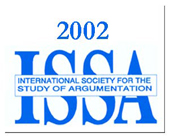ISSA Proceedings 2002 – Discourse Correspondence Between Argumentative And Grammatical Sequences
No comments yet 1. The meaning of parallelism
1. The meaning of parallelism
‘Parallelism’ in linguistics became a familiar term in the 20th century, thanks to Charles Serrus’ book “Le parallelism logico-grammatical” (1933). But the relationship between logic and grammar has been the subject of research since the end of the 19th century. See, for instance, “Raporturile între gramaticà si logicé” by the Romanian scholar Lazàr Sàineanu (1891) and especially the long methodological tradition called ‘the logical analysis of the sentence’. Are subject and predicate logical or grammatical units? To what extent must the grammatical sequence of units assimilate logical terminology, and vice-versa? I suggest recognising two levels in the content of argumentative texts, the S-level and the A-level (syntactic and argumentative levels), each one with its specific items. This is our first hypothesis. It was set up because of several terminological analogies, such as ‘(grammatical) proposition’ vs ‘(logical) proposition’, ‘concessive clause’ vs the argumentative figure called ‘concession’, the ’cause’ considered with this name in grammar as well as in logic, and so on and so forth. For more details concerning this kind of analysis see Stati, 2002. In the model of van Eemeren and Grootendorst (1981) segmentation in A-units is constantly compared with that in speech acts, whereas in our model the sequence of A-units is paralleled with the sequence of S-functions. The researcher who adopts the hypothesis of a parallelism between these two levels of analysis has to accept some prerequisites.
A complete parallelism would mean at least two properties:
– an inventory of units, equal in number, on both levels; the units enter
into syntagmatic relations in the text; these relations belong to a relatively small paradigm;
– a certain x-type relation may either belong to a traditional species (our old and familiar acquaintances ‘coordination’ and ‘subordination’) or to a new species, common to both levels; a strong parallelism could mean that to an S-relation x in (a x b) in texts always corresponds the same relation x on the A-level of the same texts considering the A-sequence (m x n). Here a, b, m, n are variables and x is a constant.
2. Confronting reality
The principal conclusion is that if it is parallelism, then it is far from being complete.
a. It is true that the terminology is similar, but only for a part of the meta-language (proposition, predicate, consecutive, conditional, concessive clauses, cause etc.);
b. another positive argument is the existence of a lexical class called ‘connectives’. It is well known that in ordinary language the same lexemes often play their role on the S-level and on the A-level as well; they signal the ‘argumentative text’ property and underline the syntactic articulation of any discourse, but the number of A-connectives which do not appear in the S-connectives list is considerable. The two paradigms of units are quite different, as a number, as well as a form of manifestation. And when we compare their actualisations in discourse we note that their correspondence is far from being bi-univocal. For instance, sometimes a couple of grammatical sentences correspond to one argumentative move, and sometimes one S-unit corresponds to a sequence of A-moves;
c. and what about the relations? In syntax we speak of co-ordination and subordination, terms quite infrequent in logical analyses. They are, however, applicable in A-analysis since situations such as the following are trivial: We may have a co-ordinative couple (a + b) not only in syntax but also in A-analysis, for example when a thesis is justified or rejected by means of two moves: a x (b + c).
d. many A-units have no equivalent on the S-level (thesis, rectification, objection, criticism, agreement etc.;) and several syntactic functions are without equivalent on the A-level (for example, clause, subject-clause, temporal subordinate clause, etc.);
e. some sequences are formed by complementary units in the sense that if a unit ‘a’ is present in the text, then unit ‘b’ should also be present. There are complementary propositions and complementary A-roles;
f. on both levels there are relations that cross the sentential frontiers;
g. the organisation is hierarchical on both levels (h) a relation ‘x’ does not only bind the elementary terms ‘b’ and ‘c’ but also complex units like'(a x b)’ and we so obtain formula:
/(a x b) x (c x d)/
and this formula means that the same relation ‘x’ binds the elementary items ‘a’ and ‘b’ and the complex items ‘(a x b)’ with ‘(c x d)’; (i) synonymity of two chunks of text occurs on the S-level and on the A-level as well. We obtain pairs of synonyms on the argumentation level by means of condensation and dilution. Numerous such synonym constructs result from the omission of one or more moves; economy does not alter the meaning of the text.
3. Two subordinate clauses
From the point of view of parallelism two categories of subordinate clauses are particularly interesting – the conditional and the concessive. The difference between the sequences which are built on the implication (if p…then q…) and those based on the equivalence relation (q… if p…) is relevant in logic and in argumentation theory, but absent – but neither impossible nor incorrect – in ordinary spoken language, cf. “You may get to speak to him if and only if you have a great mutual friend”. Logicians discuss certain types of if-clauses are of no interest for A-studies, nor for syntax, cf. “If he is a good singer, I am the king of Norway”: “If Sweden is in Africa, then Japan is a republic” (Allwood et al. 1961, 132). Obviously only grammarians investigate if-clauses that have the function of a principal sentence, cf. “If I accept this situation, it is because I love him” which means precisely “I accept this situation because I love him”. See also the status of exclamative conditional clauses, cf. Fr. “Ah, si j’étais riche!” For the analysis of if-clauses and their equivalence in French and Italian, see Weinrich, 1989, 445-446; Mazzoleni and Prandi, 1997; Stati, 2002. Finally, in A-studies, as well as in logic and in grammar, the category of counter-factuals is a common subject of research, cfr. “Les possibilités de sa non-réalisation sont plus grandes que celles de sa réalisation” (Weinrich, 1989, 445. The argumentative roles played by the if-clauses are hypothesis, condition, objection and justification As far as the concessive subordinate clauses are concerned, the lack of parallelism with the rhetorical figure called ‘concessio’ is evident.
Compare this dialogue excerpt:
A: You are obsessed with your health; death is inevitable!
B: It is true that death is unavoidable, but this does not justify neglecting one’s health…”.
Compare the definitions of the two phenomena. The argumentative item means “an obstacle which was overcome”; the syntactic clause means a momentary agreement with the antagonist’s thesis immediately followed by a polemic move (criticism, objection, rectification, contest).
Relatively rare are the occurrences of constructions which are at the same time S-concessions and A-concessions. Three disciplines investigate concessions: grammar, logic, argumentation theory. But a fundamental question arises: we have to deal with a single concept, or with two or three? Whatever the case, we are faced with a phenomenon of non-parallelism (cfr. Stati 1998).
4. Implicit propositions
Separate mention should be made to the frequent omission of propositions belonging to both species, i.e. syntactic and argumentative. I am referring to the controversial phenomenon of ellipsis, as it is called in syntax, or ‘implicitness’ as we prefer to call it in argumentation analysis. Take, for example, the formula:
“Do p, because otherwise the event q will take place”
where the proposition “and you know that q is negative for you” is implicit but present in the deep structure. Sometimes we think that the analysis could accept that two propositions are implicit, as happens in:
“Do not accept p, otherwise event q will take place, and you know that q is negative for you”
The number of implicit propositions depends on the status of “otherwise”, which seems to be equivalent to a negative conditional clause “if you do not, then q”.
Depending on the decision preferred by the researcher, we shall have one or two implicit propositions.
5. A second hypothesis: isomorphism
A second hypothesis states that the argumentative structures are similar to the syntactic structures (and to other linguistic structures too) thus participating in the more general property of linguistic forms called isomorphism, which is a kind of analogy underlined by some prominent structuralist scholars, for instance by the glossematicians. It seems that a certain methodological advantage could be obtained by applying in the A-analysis a number of categories more or less frequently employed by structuralist linguists. Among possible examples we may cite the concepts of opposition, paradigm, the extraordinary relevance of form and relation, the distinctive features, etc.. I have chosen one instance.
6. Form and substance
What corresponds in the A-analysis, to the glossematic levels form of content, and substance of content? I am talking about the dual dichotomy content vs expression and form vs substance which may represent the richest and most enduring heritage of Danish glossematics (Louis Hjelmslev). It goes without saying that here ‘form’ does not concern the material shape (the subject matter of phonetics), but the features of organisation. The four terms are combined according to the same principle, so that form is at the same time isomorphic and parallel. With ‘substance’ the question is the same, but we must pay attention to the role played by extra-linguistic features. As is well-known, the substance of the content is somehow mysterious, and the unique certainty is its vagueness. To mention but one puzzling example of an unresolved issue we may ask what synonymity actually is: a relation at the level of the form of content or at the level of the substance of content. Obviously, we mean synonymity in syntax. There is one way to draw the issue to a close by answering “syntactic synonymity does not exist at all”, nor does it exist between words.
7. Conclusions
Our cursory investigation has shown that the term ‘parallelism’ suggests a stronger relation of similarity between S-structures and A-structures than an examination of reality confirms. Nevertheless, a sort of intuition suggests that a vague affinity does exist, though it is not clearly delimited. The terminological overlaps and a long tradition that explains the syntactic articulation of language by so-called ‘logical content’ are corroborated by the scholastic ‘logical analysis of sentences’ still in use. At the same time we should stress the positive fact that implementing ‘logical analysis of the sentence’ could be helpful to teach argumentation theory. If the analogies are not exaggerated, the approximate and loose parallelism between S-structures and A-structures could turn out to be very useful. Last but not least, we should note that a constant consideration of the affinity whose limits we have underlined functions, or is apt to function, as a supplementary didactic means for the teaching of logic.
REFERENCES
Allwood, J. & Dahl, O., Logica e linguistica, Italian translation, Bologna, Il Mulino, 1961.
Van Eemeren, F. & Grootendorst, R., Speech acts in argumentative discussions, Dordrecht, Foris publications, 1984.
Mazzoleni, M. & Prandi, M., Sintassi dell’ipoteticità dialogica, in Bussi, G. E. et al. (eds..), Understanding argument. La logica informale del discorso, Bologna Clueb, 1997.
Stati, S., Principi di analisi argomentativa, Bologna, Pàtron, 2002.
Id., La concession : syntaxe, logique et argumentation, in “La linguistique”, 1998, 119-122.
Weinrich, H., Grammaire textuelle du français, Paris, Didier, 1989
You May Also Like
Comments
Leave a Reply





